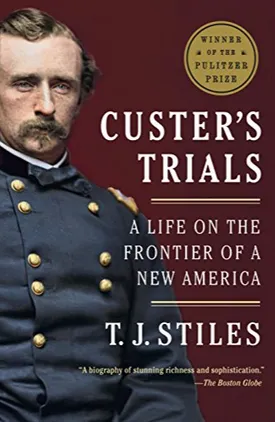Custer's Trials: A Life on the Frontier of a New America by T. J. Stiles
Custer’s Trials: A Life on the Frontier of A New America, written by Pulitzer Prize-winner T. J. Stiles, is a historical biography of General George Armstrong Custer. Stiles paints an intimate portrait of Custer’s life from his humble beginnings in small-town Ohio, to his rise to fame during the American Civil War, and finally his ultimate fall at the Battle of Little Bighorn. By utilizing the vast wealth of primary and secondary sources, Stiles provides readers new insight into a man born of conflicting forces, both the courage and recklessness of the frontier that helped shape Custer’s legacy.
Custer, born in 1839, was raised in the small town of New Rumley Ohio, where he grew up as the coddled son of a strict Methodist father and loving mother. Through Stiles’ text readers are able to gain a full view of the upbringing that shaped Custer’s world view: from learning the hard lessons of scrubbing floors, to the book knowledge from his mother and father, and the adventure of his stepfather’s tales of the frontier that inspired Custer and increased his near-obsession for detail.
Stiles follows Custer's subsequent move to military school, where he exceeded expectations and made a name for himself. He was eventually appointed to the US Army’s 7th Corps in 1861, at the start of the Civil War, and quickly rose through the ranks, earning several promotions. Custer’s reckless exploits on the battlefield, however, gradually began to overshadow his successes and eventually added to his reputation as a “boy general,” and earned him a mixed reputation. Although Custer was ever ambitious and eager for attention, Stiles’ depiction of the officer is sympathetic and even-handed, making sure to note his courage and dedication to the Union cause.
The end of the war saw Custer released from his active duty commission and become a popular lecturer on the post-war lecture circuit. But this newfound fame would not last long: by 1866, Custer had been readmitted to the US Army with a promotion to lieutenant colonel and was appointed to the newly formed 7th Cavalry Regiment. Stiles draws on Custer’s own autobiography and other accounts to offer a vivid picture of the post-war America and of the heroism, ambition, and violence that built the new nation.
It was here that Custer’s story reaches its most dramatic climax. Stiles traces Custer’s moves during the Great Sioux War of 1876, following him as ultimately leading more than 800 men in an attack on the camp of Chief Sitting Bull at Little Big Horn. It was here that Custer, and his entire command, met their demise in the Battle of Little Bighorn. Stiles draws on a wealth of primary sources about the battle to give readers a unique insight into the tragedy that sealed Custer’s fate.
In the end, Stiles succeeds in combining a narrative history with biographical detail to present a vivid portrait of Custer's life. Heavily grounded in a multitude of primary and secondary sources, Stiles' Custer’s Trials : A Life on the Frontier of A New America is a must-read for any history enthusiast looking for a new perspective on one of the most controversial figures of the 19th century.

